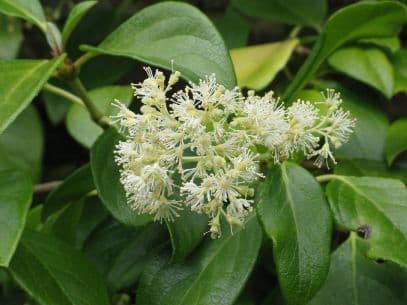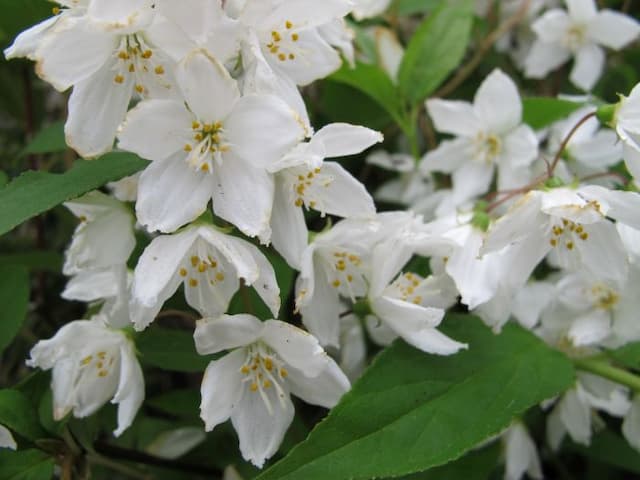Slender Deutzia Deutzia gracilis 'Nikko'

ABOUT
Deutzia 'Nikko', commonly known as Slender Deutzia, is distinguished by its delicate, arching branches that showcase a cascade of white flowers. The blooms, which typically appear in late spring to early summer, are small and star-shaped, clustering together in abundant sprays that can almost entirely cover the foliage. The leaves of Slender Deutzia are bright green, narrow and simple, lending a fine texture to the garden landscape. As the seasons change, the foliage may transform into a striking deep purplish-red, providing notable fall color. This deciduous shrub has a rounded, bushy habit, contributing an elegant and graceful shape to its surroundings. The overall appearance of Deutzia 'Nikko' is one of a light and airy plant, offering a display of bountiful blossoms and attractive foliage that adds beauty and interest to gardens without commanding significant space.
About this plant
 Names
NamesFamily
Hydrangeaceae
Synonyms
Slender Deutzia, Nikko Deutzia
Common names
Deutzia gracilis var. nana, Deutzia nana.
 Toxicity
ToxicityTo humans
Slender deutzia is generally considered non-toxic to humans. There are no well-documented cases of poisoning from ingesting this plant, and it is not typically associated with adverse effects if accidentally consumed.
To pets
Slender deutzia is not known to be toxic to pets. There are no significant toxic effects expected if pets chew on or ingest this plant. It is not listed as a plant that's commonly associated with pet poisoning.
 Characteristics
CharacteristicsLife cycle
Perennials
Foliage type
Deciduous
Color of leaves
Green
Flower color
White
Height
2 feet (60 cm)
Spread
5 feet (150 cm)
Plant type
Shrub
Hardiness zones
5
Native area
Japan
Benefits
 General Benefits
General Benefits- Ornamental Appeal: Slender Deutzia 'Nikko' features cascading branches of white flowers in spring, providing visual interest in garden landscapes.
- Compact Size: It remains small and low-growing, making it excellent for use in limited space areas and smaller gardens.
- Seasonal Interest: Offers year-round interest with spring blooms, summer green foliage, and reddish-purple fall coloration.
- Easy Maintenance: It is known for being low-maintenance, requiring minimal pruning and care once established.
- Drought Tolerance: Once established, 'Nikko' can tolerate periods of drought, reducing the need for frequent watering.
- Pest Resistance: Generally resistant to pests, which minimizes the need for chemical treatments.
- Frost Hardy: It is tolerant of cold temperatures and can survive through frosts and cold snaps.
- Versatility in Landscape: Can be used in various landscape applications including ground cover, borders, and as a foundation plant.
- Attracts Pollinators: The flowers are attractive to bees and butterflies, which are beneficial for pollination in the garden.
- Erosion Control: With its dense growth habit, it can help prevent soil erosion on slopes and embankments.
 Medical Properties
Medical PropertiesThis plant is not used for medical purposes.
 Air-purifying Qualities
Air-purifying QualitiesThis plant is not specifically known for air purifying qualities.
 Other Uses
Other Uses- Living Mulch: Deutzia gracilis 'Nikko' can be used as a form of living mulch, providing a dense ground cover that suppresses weeds and retains soil moisture.
- Erosion Control: Its extensive root system helps stabilize slopes and banks, making it useful for erosion control in landscape settings.
- Wildlife Shelter: The thicket-like growth habit can offer small wildlife a safe haven from predators and harsh weather conditions.
- Photography Backdrops: The beautiful white blossoms of the Nikko can serve as a splendid backdrop for garden photography and outdoor portrait sessions.
- Garden Borders: It can be planted along the edges of garden paths or driveways to create a defined border with seasonal interest.
- Fairy Gardens: Due to its small size and fine texture, the Nikko is well-suited for use in fairy and miniature gardens for a whimsical effect.
- Bonsai Specimen: With careful pruning, the Nikko can be trained into a bonsai form, showcasing its elegant structure in a miniature landscape.
- Seasonal Decorations: Branches can be clipped and used as greenery in holiday wreaths and floral arrangements during its blooming season.
- Privacy Screens: When planted in groups, Deutzia gracilis 'Nikko' can form a low, dense hedge providing privacy for ground-level patio areas or gardens.
- Ecological Studies: The plant can be used in ecological studies to understand the benefits of native and ornamental shrubbery on local ecosystems.
Interesting Facts
 Feng Shui
Feng ShuiThe Slender deutzia is not used in Feng Shui practice.
 Zodiac Sign Compitability
Zodiac Sign CompitabilityThe Slender deutzia is not used in astrology practice.
 Plant Symbolism
Plant Symbolism- Purity: The Deutzia gracilis 'Nikko', commonly known as Slender Deutzia, often symbolizes purity due to its delicate white flowers.
- Innocence: Its modest and clean appearance gives the Slender Deutzia an association with innocence.
- Humility: The plant's unassuming nature and its tendency to blend into the background can represent humility.
- Transient Beauty: As the Slender Deutzia blooms spectacularly but only for a short period, it can symbolize the fleeting nature of beauty.
 Water
WaterSlender deutzia should be watered deeply to encourage a strong root system, which means the soil should be moistened several inches below the surface. During the first growing season, it's important to maintain a regular watering schedule, watering once a week if there hasn't been significant rainfall. Generally, the slender deutzia needs about one inch of water per week, which is roughly equivalent to 0.623 gallons per square yard of soil area. Adjust the frequency of watering based on weather conditions, watering more often during hot, dry periods and reducing it when there is ample rain. It is crucial to avoid overwatering as it can lead to root rot.
 Light
LightSlender deutzia thrives in full sun to partial shade conditions. Ideally, it should receive at least four to six hours of direct sunlight each day with some dappled shade during the hottest part of the afternoon. Planting this shrub in a location where it can enjoy morning sunlight with some protection from the intense late day sun helps ensure abundant flowering and good plant health.
 Temperature
TemperatureThe slender deutzia prefers temperate conditions and is hardy in a range of temperatures, tolerating a minimum temperature of about -10°F and a maximum of 100°F. However, it grows best when the temperature is between 60°F and 80°F. It is important to protect the plant from extreme heat or cold, especially during the winter by providing mulch and, if needed, a frost blanket.
 Pruning
PruningSlender deutzia benefits from pruning to maintain its shape, encourage more blooms, and remove any dead or diseased branches. It is best pruned immediately after it finishes blooming in late spring or early summer. This timing allows for the trimming of spent flowers and shaping of the plant without the risk of cutting off next year's buds. Depending on growth, prune branches back by one-third to one-half every year or every other year.
 Cleaning
CleaningAs needed
 Soil
SoilThe ideal soil mix for Nikko is one that is well-draining yet retains moisture, with a pH range of 5.5 to 7.0. Loamy soil enriched with compost or well-rotted manure will provide the necessary nutrients. A blend of two parts garden soil, one part sand, and one part organic matter can work well for this plant.
 Repotting
RepottingDeutzia gracilis 'Nikko', commonly known as Slender Deutzia, generally does not require frequent repotting and can be done every 2-3 years. Check the root system in the spring and repot if the roots have become pot-bound.
 Humidity & Misting
Humidity & MistingSlender Deutzia thrives in average humidity levels found in outdoor garden environments. It does not have specific humidity requirements but prefers not to be in overly dry air.
 Suitable locations
Suitable locationsIndoor
Place in bright, indirect light and keep soil moderately moist.
Outdoor
Plant in partial shade, well-drained soil, water regularly.
Hardiness zone
5-8 USDA
 Life cycle
Life cycleDeutzia gracilis 'Nikko', commonly known as Slender Deutzia, begins its life cycle when seeds germinate in spring, given proper conditions of moisture and temperature. Once germinated, the seedlings grow into young plants, developing a root system and foliage through the spring and summer. As they mature, these deciduous shrubs enter a vigorous growth phase, forming arching branches covered with dense, bright green leaves. Slender Deutzia blooms in late spring to early summer, producing clusters of small, fragrant white flowers, which are important for pollination and subsequent seed formation. After flowering, the plant sets seed, which, once mature, disperses into the environment, completing the reproductive stage. In autumn, the leaves turn a bronze-purple color before falling off as the plant enters dormancy during winter, conserving energy for the next growth cycle.
 Propogation
PropogationPropogation time
Spring to Early Summer
The most popular method of propagation for Deutzia gracilis 'Nikko', commonly known as Slender Deutzia, is via softwood cuttings. This process is ideally carried out in late spring or early summer when the plant's new growth is still tender and flexible. Gardeners should choose healthy, non-flowering shoots and make cuttings about 4 to 6 inches (10 to 15 cm) long, ensuring each cutting has several leaves. The lower leaves are removed, and the cut end is dipped in rooting hormone to encourage root development. The cutting should then be planted in a pot filled with a mix of peat and perlite to provide good drainage and aeration. Consistently maintaining moisture without overwatering is critical, and a location with indirect light will help to prevent the cutting from drying out. Roots typically develop within a few weeks, after which the new Slender Deutzia plants can be transplanted to their permanent location.






![Rose deutzia [Yuki Cherry Blossom]](/_next/image?url=https%3A%2F%2Fplants-admin.emdemapps.com%2Fimages%2Fplants%2F%2Fimages%2F604b6510a383a.png&w=640&q=75)
![Hydrangea [Hot Chocolate]](/_next/image?url=https%3A%2F%2Fplants-admin.emdemapps.com%2Fimages%2Fplants%2F%2Fimages%2F604b5a066e3bd.png&w=640&q=75)
![Hydrangea [Blackberry Pie]](/_next/image?url=https%3A%2F%2Fplants-admin.emdemapps.com%2Fimages%2Fplants%2F%2Fimages%2F604b56e2abc1d.png&w=640&q=75)
